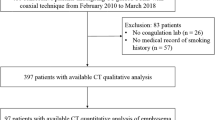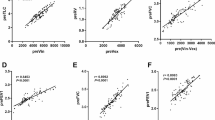Abstract
Objectives
In lung cancer resection, chronic obstructive pulmonary disease is a risk factor for post-operative complications. Few studies on post-operative complications of lung cancer resection have considered radiographic emphysematous change as an index. Here, we have examined the relationship between the regional ratio of the emphysematous area in pre-operative computed tomography images and cardiopulmonary complications in patients with chronic obstructive pulmonary disease who underwent lung cancer resection.
Methods
We retrospectively evaluated 159 patients with chronic obstructive pulmonary disease who underwent lobectomy for lung cancer at Shizuoka Cancer Center Hospital, Shizuoka, Japan, between 2002 and 2011. Pre-operative factors, including the proportion of the emphysematous area measured by computed tomography as a percentage of the low attenuation area (LAA%), as well as intraoperative factors were analyzed. Cardiopulmonary complications, including pyothorax, pneumonia and atelectasis, acute pulmonary injury, indwelling chest tube, long duration of oxygen supply, and arrhythmia, were evaluated.
Results
Cardiopulmonary complications were observed among 61 patients (38%). Univariate analysis revealed that patient age, percentage of forced expiratory volume in 1 s, LAA%, and volume of blood loss were significantly associated with cardiopulmonary complications. Multivariate analysis indicated patient age and LAA% as being significant independent predictors of cardiopulmonary complications.
Conclusions
The regional ratio of the emphysematous area is useful for predicting cardiopulmonary complications in patients with chronic obstructive pulmonary disease who undergo lobectomy for lung cancer. In such patients who are also ≥ 70 years of age and exhibit LAA% ≥ 1.0%, careful intra- and post-operative management is warranted.


Similar content being viewed by others
References
Licker MJ, Widikker I, Robert J, Frey JG, Spiliopoulos A, Ellenberger C, et al. Operative mortality and respiratory complications after lung resection for cancer: impact of chronic obstructive pulmonary disease and time trends. Ann Thorac Surg. 2006;81:1830–7.
Colice GL, Shafazand S, Griffin JP, Keenan R, Bolliger CT, American College of Chest Physicians. Physiologic evaluation of the patient with lung cancer being considered for resectional surgery: ACCP evidenced-based clinical practice guidelines (2nd ed.). Chest. 2007;132:161S–177S.
Gevenois PA, De Vuyst P, Sy M, Scillia P, Chaminade L, de Maertelaer V, et al. Pulmonary emphysema. Quantitative CT during expiration. Radiology. 1996;199:825–9.
Wang Z, Gu S, Leader JK, Kundu S, Tedrow JR, Sciurba FC, et al. Optimal threshold in CT quantification of emphysema. Eur Radiol. 2013;23:975–84.
Gevenois PA, De Vuyst P, de Maertelaer V, Zanen J, Jacobovitz D, Cosio MG, et al. Comparison of computed density and microscopic morphometry in pulmonary emphysema. Am J Respir Crit Care Med. 1996;154:187–92.
Dransfield MT, Washko GR, Foreman MG, Estepar RS, Reilly J, Bailey WC. Gender differences in the severity of CT emphysema in COPD. Chest. 2007;132:464–70.
Martinez FJ, Foster G, Curtis JL, Criner G, Weinmann G, Fishman A, et al. Predictors of mortality in patients with emphysema and severe airflow obstruction. Am J Respir Crit Care Med. 2006;173:1326–34.
Lomas DA, Silverman EK, Edwards LD, Miller BE, Coxson HO, Tal-Singer R, et al. Evaluation of serum CC-16 as a biomarker for COPD in the ECLIPSE cohort. Thorax. 2008;63:1058–63.
Patel BD, Coxson HO, Pillai SG, Agustí AG, Calverley PM, Donner CF, et al. Airway wall thickening and emphysema show independent familial aggregation in chronic obstructive pulmonary disease. Am J Respir Crit Care Med. 2008;178:500–5.
Gevenois PA, Yarnault JC. Can computed tomography quantify pulmonary emphysema? Eur Respir J. 1995;5:843–8.
Mishima M, Hirai T, Jin Z, Oku Y, Sakai N, Nakano Y, et al. Standardization of low attenuation area versus total lung area in chest X-ray CT as an indicator of chronic pulmonary emphysema. Front Med Biol Eng. 1997;8:79–86.
Kinsella M, Müller NL, Abboud RT, Morrison NJ, DyBuncio A. Quantitation of emphysema by computed tomography using a “density mask” program and correlation with pulmonary function tests. Chest. 1990;97:315–21.
Sanders C, Nath PH, Bailey WC. Detection of emphysema with computed tomography. Correlation with pulmonary function tests and chest radiography. Invest Radiol. 1988;23:262–6.
Goddard PR, Nicholson EM, Laszlo G, Watt I. Computed tomography in pulmonary emphysema. Clin Radiol. 1982;33:379–87.
Madani A, Keyzer C, Gevenois PA. Quantitative computed tomography assessment of lung structure and function in pulmonary emphysema. Eur Respir J. 2001;18:720–30.
Schroeder JD, McKenzie AS, Zach JA, Wilson CG, Curran-Everett D, Stinson DS, et al. Relationships between airflow obstruction and quantitative CT measurements of emphysema, air trapping, and airways in subjects with and without chronic obstructive pulmonary disease. AJR Am J Roentgenol. 2013;201:W460-70.
Crisafulli E, Alfieri V, Silva M, Aiello M, Tzani P, Milanese G, et al. Relationships between emphysema and airways metrics at High-Resolution Computed Tomography (HRCT) and ventilatory response to exercise in mild to moderate COPD patients. Respir Med. 2016;117:207–14.
Diaz AA, Bartholmai B, San José Estépar R, Ross J, Matsuoka S, Yamashiro T, et al. Relationship of emphysema and airway disease assessed by CT to exercise capacity in COPD. Respir Med. 2010;104:1145–51.
Mizuno S, Takiguchi Y, Fujikawa A, Motoori K, Tada Y, Kurosu K, et al. Chronic obstructive pulmonary disease and interstitial lung disease in patients with lung cancer. Respirology. 2009;14:377–83.
Gierada DS, Yusen RD, Villanueva IA, Pilgram TK, Slone RM, Lefrak SS, et al. Patient selection for lung volume reduction surgery: an objective model based on prior clinical decisions and quantitative CT analysis. Chest. 2000;117:991–8.
Bae KT, Slone RM, Gierada DS, Yusen RD, Cooper JD. Patients with emphysema: quantitative CT analysis before and after lung volume reduction surgery. Work in progress. Radiology. 1997;203:705–14.
Cederlund K, Tylén U, Jorfeldt L, Aspelin P. Classification of emphysema in candidates for lung volume reduction surgery: a new objective and surgically oriented model for describing CT severity and heterogeneity. Chest. 2002;122:590–6.
Nakano Y, Coxson HO, Bosan S, Rogers RM, Sciurba FC, Keenan RJ, et al. Core to rind distribution of severe emphysema predicts outcome of lung volume reduction surgery. Am J Respir Crit Care Med. 2001;164:2195–9.
Flaherty KR, Kazerooni EA, Curtis JL, Iannettoni M, Lange L, Schork MA, et al. Short-term and long-term outcomes after bilateral lung volume reduction surgery: prediction by quantitative CT. Chest. 2001;119:1337–46.
Ueda K, Kaneda Y, Sudoh M, Mitsutaka J, Tanaka N, Suga K, et al. Role of quantitative CT in predicting hypoxemia and complications after lung lobectomy for cancer, with special reference to area of emphysema. Chest. 2005;128:3500–6.
Ueda K, Kaneda Y, Sudo M, Mitsutaka J, Li TS, Suga K, et al. Quantitative computed tomography versus spirometry in predicting air leak duration after major lung resection for cancer. Ann Thorac Surg. 2005;80:1853–8.
Mohamed Hoesein FA, de Hoop B, Zanen P, Gietema H, Kruitwagen CL, van Ginneken B, et al. CT-quantified emphysema in male heavy smokers: association with lung function decline. Thorax. 2011;66:782–7.
Lutchmedial SM, Creed WG, Moore AJ, Walsh RR, Gentchos GE, Kaminsky DA. How common is airflow limitation in patients with emphysema on CT scan of the chest? Chest. 2015;148:176–84.
Mets OM, de Jong PA, van Ginneken B, Gietema HA, Lammers JW. Quantitative computed tomography in COPD: possibilities and limitations. Lung. 2012;190:133–45.
Funding
This study did not receive outside financial support.
Author information
Authors and Affiliations
Corresponding author
Ethics declarations
Conflict of interest
The authors have declared that no conflict of interest exists.
Additional information
Publisher’s Note
Springer Nature remains neutral with regard to jurisdictional claims in published maps and institutional affiliations.
Rights and permissions
About this article
Cite this article
Yasuura, Y., Maniwa, T., Mori, K. et al. Quantitative computed tomography for predicting cardiopulmonary complications after lobectomy for lung cancer in patients with chronic obstructive pulmonary disease. Gen Thorac Cardiovasc Surg 67, 697–703 (2019). https://doi.org/10.1007/s11748-019-01080-z
Received:
Accepted:
Published:
Issue Date:
DOI: https://doi.org/10.1007/s11748-019-01080-z




